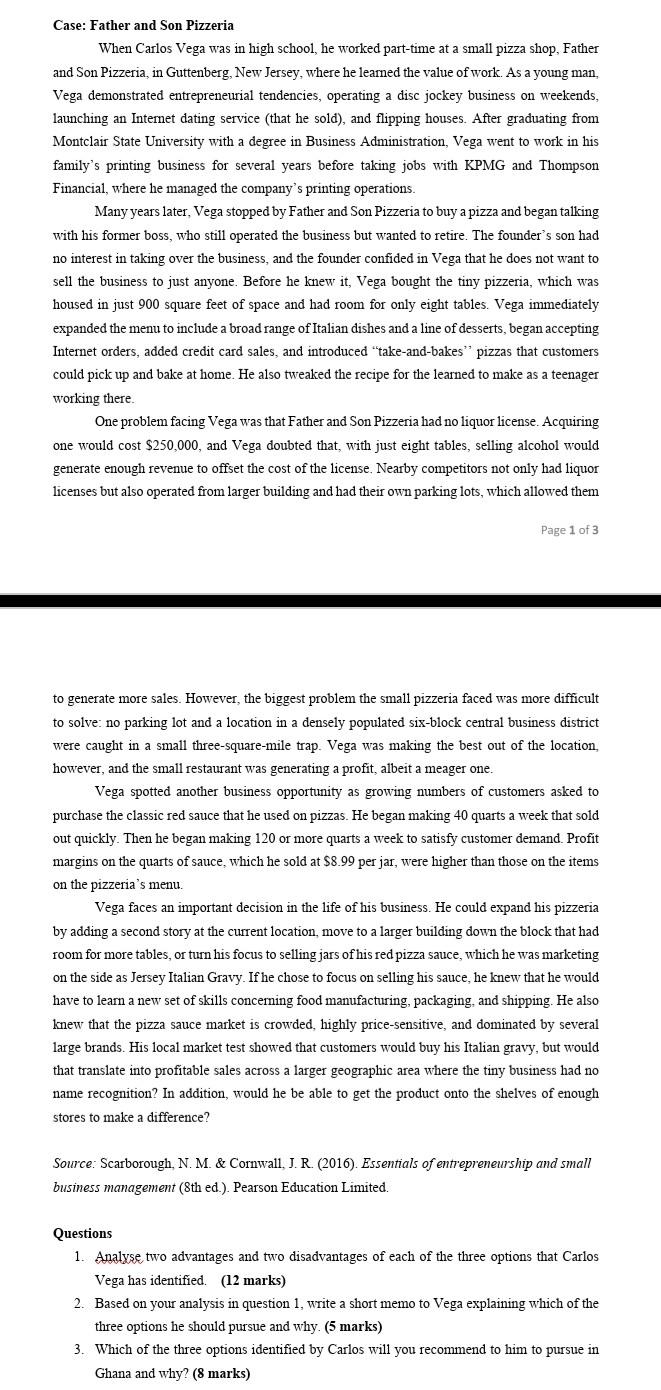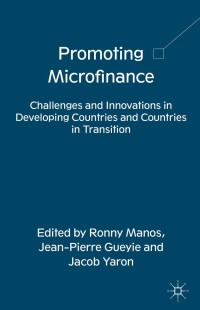Answered step by step
Verified Expert Solution
Question
1 Approved Answer
Entrepreneurship Answer questions 1 Case: Father and Son Pizzeria When Carlos Vega was in high school, he worked part-time at a small pizza shop, Father

Entrepreneurship Answer questions 1
Case: Father and Son Pizzeria When Carlos Vega was in high school, he worked part-time at a small pizza shop, Father and Son Pizzeria, in Guttenberg, New Jersey, where he learned the value of work. As a young man, Vega demonstrated entrepreneurial tendencies, operating a disc jockey business on weekends, launching an Internet dating service (that he sold), and flipping houses. After graduating from Montclair State University with a degree in Business Administration, Vega went to work in his family's printing business for several years before taking jobs with KPMG and Thompson Financial, where he managed the company's printing operations. Many years later, Vega stopped by Father and Son Pizzeria to buy a pizza and began talking with his former boss, who still operated the business but wanted to retire. The founder's son had no interest in taking over the business, and the founder confided in Vega that he does not want to sell the business to just anyone. Before he knew it, Vega bought the tiny pizzeria, which was housed in just 900 square feet of space and had room for only eight tables. Vega immediately expanded the menu to include a broad range of Italian dishes and a line of desserts, began accepting Internet orders, added credit card sales, and introduced "take-and-bakes" pizzas that customers could pick up and bake at home. He also tweaked the recipe for the learned to make as a teenager working there. One problem facing Vega was that Father and Son Pizzeria had no liquor license. Acquiring one would cost $250,000, and Vega doubted that, with just eight tables, selling alcohol would generate enough revenue to offset the cost of the license. Nearby competitors not only had liquor licenses but also operated from larger building and had their own parking lots, which allowed them Page 1 of 3 to generate more sales. However, the biggest problem the small pizzeria faced was more difficult to solve: no parking lot and a location in a densely populated six-block central business district were caught in a small three-square-mile trap. Vega was making the best out of the location, however, and the small restaurant was generating a profit, albeit a meager one. Vega spotted another business opportunity as growing numbers of customers asked to purchase the classic red sauce that he used on pizzas. He began making 40 quarts a week that sold out quickly. Then he began making 120 or more quarts a week to satisfy customer demand. Profit margins on the quarts of sauce, which he sold at $8.99 per jar, were higher than those on the items on the pizzeria's menu. Vega faces an important decision in the life of his business. He could expand his pizzeria by adding a second story at the current location, move to a larger building down the block that had room for more tables, or turn his focus to selling jars of his red pizza sauce, which he was marketing on the side as Jersey Italian Gravy. If he chose to focus on selling his sauce, he knew that he would have to learn a new set of skills concerning food manufacturing, packaging, and shipping. He also knew that the pizza sauce market is crowded, highly price-sensitive, and dominated by several large brands. His local market test showed that customers would buy his Italian gravy, but would that translate into profitable sales across a larger geographic area where the tiny business had no name recognition? In addition, would he be able to get the product onto the shelves of enough stores to make a difference? Source: Scarborough, N. M. \& Cornwall, J. R. (2016). Essentials of entrepreneurship and small business management (8th ed.). Pearson Education Limited. Questions 1. Analyse two advantages and two disadvantages of each of the three options that Carlos Vega has identified. (12 marks) 2. Based on your analysis in question 1 , write a short memo to Vega explaining which of the three options he should pursue and why. (5 marks) 3. Which of the three options identified by Carlos will you recommend to him to pursue in Ghana and why? (8 marks) Case: Father and Son Pizzeria When Carlos Vega was in high school, he worked part-time at a small pizza shop, Father and Son Pizzeria, in Guttenberg, New Jersey, where he learned the value of work. As a young man, Vega demonstrated entrepreneurial tendencies, operating a disc jockey business on weekends, launching an Internet dating service (that he sold), and flipping houses. After graduating from Montclair State University with a degree in Business Administration, Vega went to work in his family's printing business for several years before taking jobs with KPMG and Thompson Financial, where he managed the company's printing operations. Many years later, Vega stopped by Father and Son Pizzeria to buy a pizza and began talking with his former boss, who still operated the business but wanted to retire. The founder's son had no interest in taking over the business, and the founder confided in Vega that he does not want to sell the business to just anyone. Before he knew it, Vega bought the tiny pizzeria, which was housed in just 900 square feet of space and had room for only eight tables. Vega immediately expanded the menu to include a broad range of Italian dishes and a line of desserts, began accepting Internet orders, added credit card sales, and introduced "take-and-bakes" pizzas that customers could pick up and bake at home. He also tweaked the recipe for the learned to make as a teenager working there. One problem facing Vega was that Father and Son Pizzeria had no liquor license. Acquiring one would cost $250,000, and Vega doubted that, with just eight tables, selling alcohol would generate enough revenue to offset the cost of the license. Nearby competitors not only had liquor licenses but also operated from larger building and had their own parking lots, which allowed them Page 1 of 3 to generate more sales. However, the biggest problem the small pizzeria faced was more difficult to solve: no parking lot and a location in a densely populated six-block central business district were caught in a small three-square-mile trap. Vega was making the best out of the location, however, and the small restaurant was generating a profit, albeit a meager one. Vega spotted another business opportunity as growing numbers of customers asked to purchase the classic red sauce that he used on pizzas. He began making 40 quarts a week that sold out quickly. Then he began making 120 or more quarts a week to satisfy customer demand. Profit margins on the quarts of sauce, which he sold at $8.99 per jar, were higher than those on the items on the pizzeria's menu. Vega faces an important decision in the life of his business. He could expand his pizzeria by adding a second story at the current location, move to a larger building down the block that had room for more tables, or turn his focus to selling jars of his red pizza sauce, which he was marketing on the side as Jersey Italian Gravy. If he chose to focus on selling his sauce, he knew that he would have to learn a new set of skills concerning food manufacturing, packaging, and shipping. He also knew that the pizza sauce market is crowded, highly price-sensitive, and dominated by several large brands. His local market test showed that customers would buy his Italian gravy, but would that translate into profitable sales across a larger geographic area where the tiny business had no name recognition? In addition, would he be able to get the product onto the shelves of enough stores to make a difference? Source: Scarborough, N. M. \& Cornwall, J. R. (2016). Essentials of entrepreneurship and small business management (8th ed.). Pearson Education Limited. Questions 1. Analyse two advantages and two disadvantages of each of the three options that Carlos Vega has identified. (12 marks) 2. Based on your analysis in question 1 , write a short memo to Vega explaining which of the three options he should pursue and why. (5 marks) 3. Which of the three options identified by Carlos will you recommend to him to pursue in Ghana and why? (8 marks)Step by Step Solution
There are 3 Steps involved in it
Step: 1

Get Instant Access to Expert-Tailored Solutions
See step-by-step solutions with expert insights and AI powered tools for academic success
Step: 2

Step: 3

Ace Your Homework with AI
Get the answers you need in no time with our AI-driven, step-by-step assistance
Get Started


